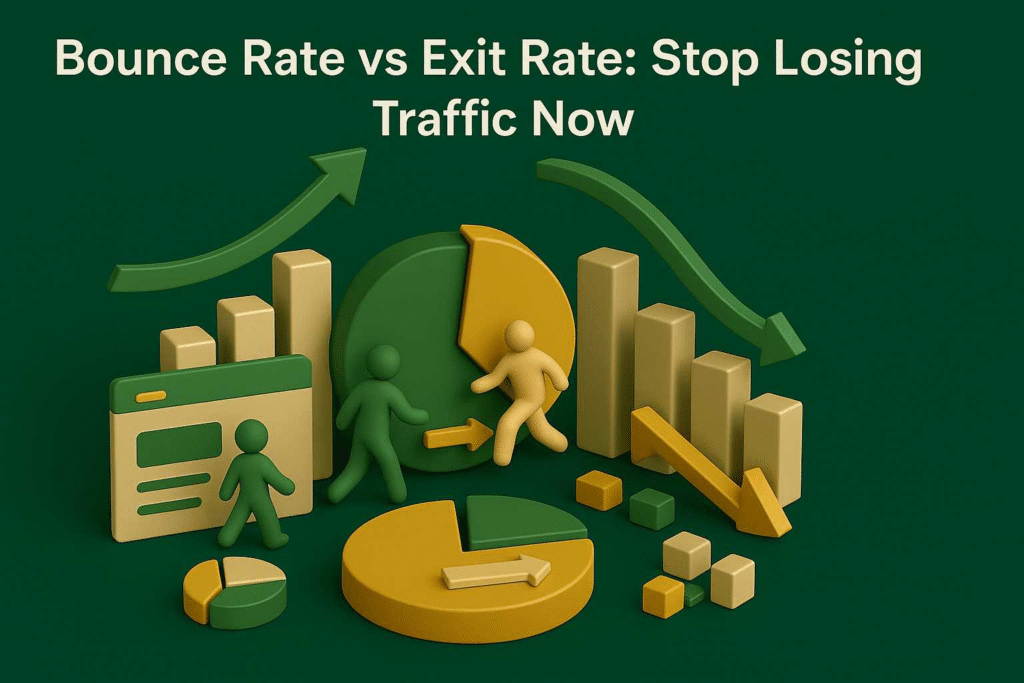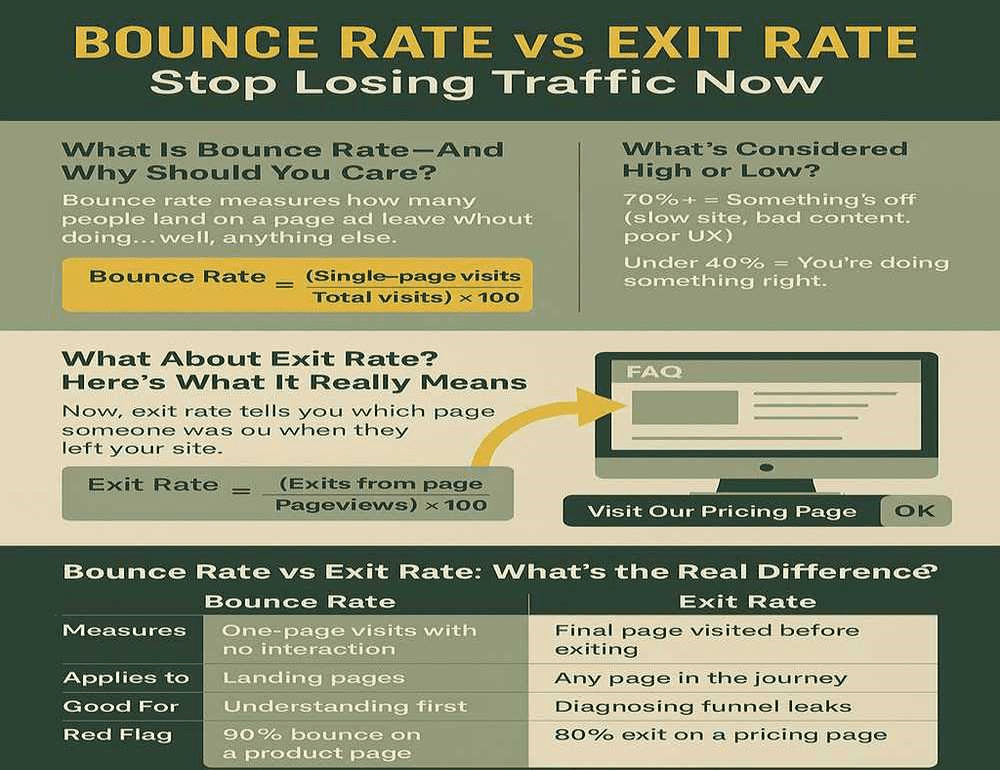
Ever look at your website analytics and wonder why people are leaving your site—but can’t quite figure out where or why? That’s where two often-confused metrics come in: bounce rate vs exit rate.
They sound similar, right? But they point to entirely different user behaviors. And when you understand the distinction, you’ll start seeing exactly where your site shines—and where it silently bleeds traffic.
Let’s break this down into real-world terms so you can take action, boost engagement, and convert more visitors—starting today.
What Is Bounce Rate—And Why Should You Care?
Let’s say someone finds your blog on Google, clicks through, scans the first paragraph, and leaves without clicking anything else. That’s a bounce. They entered and exited on the same page without taking another action.
In Plain English
Bounce rate measures how many people land on a page and leave without doing… well, anything else.
Simple Math Behind It
java
CopyEdit
Bounce Rate = (Single-page visits ÷ Total visits) × 100
A Quick Example
Imagine 500 people land on your article “Best Free SEO Tools.” If 300 of them leave without clicking to another page, that bounce rate is 60%.
What’s Considered High or Low?
- 70%+ = Something’s off (slow site, bad content, poor UX).
- Under 40% = You’re doing something right.
But context is everything. A blog post might naturally have a higher bounce rate than a checkout page—and that’s okay.
Want to rank pages even if you’re not earning tons of links? You’ll love this clever, Google-approved approach: Rank Without Backlinks.
What About Exit Rate? Here’s What It Really Means
Now, exit rate tells you which page someone was on when they left your site. Unlike bounce rate, it doesn’t care where they started—it just cares where the journey ended.
Quick Math
vbnet
CopyEdit
Exit Rate = (Exits from page ÷ Pageviews) × 100
An Easy Example
Let’s say your FAQ page got 1,000 views and 700 people left after reading it. That’s a 70% exit rate. But if your “Pricing” page has the same number? You might be losing leads.
Need to fix a leaky funnel? Check out how we’ve optimized ours: Visit Our Pricing Page to see it in action.
When Exit Rates Are OK
High exit rates on thank-you or blog conclusion pages? No problem. High exit rates mid-funnel or on conversion pages? That’s a red flag.
Bounce Rate vs Exit Rate: What’s the Real Difference?
Here’s where people get tripped up. Both metrics track exits. But bounce rate measures non-engagement, while exit rate just tracks where people leave from.
| Metric | Bounce Rate | Exit Rate |
| Measures | One-page visits with no interaction | Final page visited before exiting |
| Applies to | Landing pages | Any page in the journey |
| Good For | Understanding first impressions | Diagnosing funnel leaks |
| Red Flag Example | 90% bounce on a product page | 80% exit on a pricing page |
In short: bounce rate vs exit rate is about who’s not engaging vs who’s done navigating.

When Should You Track Bounce Rate or Exit Rate?
Knowing which metric to look at (and when) makes you a sharper marketer. Here’s the cheat sheet:
Focus on Bounce Rate When:
- You want to test landing pages
- You’re optimizing blog content
- You’re checking audience-content match
Use Exit Rate To:
- Track leaks in your funnel
- Optimize user flow in multi-page journeys
- Pinpoint drop-off zones
If users are leaving too soon, maybe they’re not finding what they expected—or maybe there’s no clear next step.
How to Improve Bounce Rate and Exit Rate the Smart Way
Let’s stop traffic from leaking. Here’s how to hold attention longer and guide users through your site like pros do.
For a more detailed breakdown of bounce rate strategies and how they affect SEO, check out Semrush’s in-depth guide on bounce rate.
Improve UX and Layout
- Keep pages clutter-free
- Use readable fonts
- Optimize for mobile (always)
Match Content With Search Intent
If your headline promises a list of tools, don’t bury it under 5 paragraphs of fluff. Deliver fast, then expand.
Guide the Journey With Links and CTAs
Use internal links and visual buttons to keep the user flowing. Speaking of which, our Link Acquisition guide can help you create those high-value pages that people actually want to explore.
Leverage GA4’s Modern Metrics
Bounce rate looks different in GA4—it now reflects lack of engagement, which includes:
- Sessions under 10 seconds
- No conversions
- No second page views
Want a deeper dive into event-based tracking? Visit Google’s official GA4 guide to start mastering your data.
Understanding Bounce Rate vs Exit Rate in GA4
In Google Analytics 4, bounce rate vs exit rate takes on a modern form. Bounce rate isn’t about single-page sessions anymore. It’s more about whether the visitor was engaged. That means someone who reads for 15 seconds and scrolls doesn’t count as a bounce—even if they don’t click.
GA4 Gives You Tools Like:
- Funnel Exploration Reports
- Engagement Time Tracking
- Scroll Depth and Click Events
GA4 completely redefines how we analyze Bounce Rate vs Exit Rate, focusing more on engagement signals than static page views.
The result? A fuller picture of who’s bouncing, who’s exiting, and who’s still curious.
Final Thoughts: Use Both Metrics to Win at SEO
If you’re only looking at one of these, you’re missing half the story. Bounce rate vs exit rate tells you what’s broken at both the entry and exit doors of your site. Bounce rate tells you about that first impression, while exit rate tells you how it ends. Together, they show you exactly where users lose interest—and how to get them to stay.
Want to take your strategy further? Head over to our Homepage and explore a library of smart SEO
Frequently Asked Questions
What’s the difference between bounce rate and exit rate?
Bounce rate tracks single-page, no-interaction visits. Exit rate tracks where users end their visit—regardless of how many pages they viewed.
Can a page have both high bounce and exit rates?
Absolutely. A blog post might be both the first and last thing a visitor sees.
Which one is worse? High bounce or high exit?
Depends on the page. High bounce on landing pages = bad. High exit on checkout confirmation = normal.
How do I reduce bounce rate fast?
Speed up your site, improve mobile experience, simplify content, and add clear CTAs.
Does bounce rate affect SEO?
Indirectly. Google may interpret high bounce as low relevance—especially if visitors return to the search results quickly.
Where should I start optimizing first?
Start with your top-performing landing pages. Use tools like GA4 to track engagement and scroll events.
